UP Board Notes for Class 10 Science Chapter 3 Heredity And Genetics Learning Objectives
After completing this chapter, you will be able to:
- Define heredity and variation;
- Understand Mendel’s contributions to genetics;
- Describe Mendel’s laws of inheritance;
- Explain the chromosomal basis of sex determination in humans:
- Describe the pattern of inheritance of sex-linked genes;
- Identify the characteristics that follow X and Y sex-linked inheritance;
- Give examples of sex-linked inheritance of diseases, namely, haemophilia and colour blindness.
In the earlier chapters, you have already studied about the structure of chromosomes and what happens to them during meiosis. You have also studied that genes are the carriers of heredity located on the chromosomes. In this chapter, you will study about the fundamentals of genetics, which includes Mendel’s laws of inheritance and sex-linked inheritance of diseases.
UP Board Notes for Class 10 Science Chapter 3 Heredity And Genetics Geredity And Variations
‘Like begets like’, which means young ones resemble their parents, is the well-known dogma associated with heredity. Heredity is the cause of similarities between individuals of a species.
Transmission of genetically based characteristics from parents to the successive generation is called heredity or inheritance.
Though offsprings resemble their parents, they are not identical. They usually differ among themselves and also from their parents. Even twins show resemblance in many respects, yet they show differences in certain features. Differences in the genetic characteristics or traits among individuals of a species are called variations.
The science that deals with the study of mechanisms responsible for similarities and differences among closely related species is called genetics.
| Class 10 Science | Class 11 Chemistry |
| Class 11 Chemistry | Transformation of Sentences |
| Class 8 Maths | Class 8 Science |
W. Bateson was the first one to coin the term genetics in 1905. It is derived from the Greek word genesis meaning to grow into or to become. In other words, genetics is the study of heredity and variations. However, Mendel is known as the ‘Father of genetics.
Some important terms used in genetics
- Chromosomes: Filamentous bodies present in thenucleus of a cell, composed of chromatin material (DNA-protein complex).
- Variation: Different genetic characteristics or traits produced in individuals of the same species.
- Gene: It is the basic unit of inheritance. It is a segment of DNA found on the chromosome, which controls the expression of a character. It is passed from the parents to the offsprings.
- Homologous chromosomes: A pair of corresponding chromosomes of the same size and shape, one from each parent.
- Alleles: Alleles are alternating molecular forms of a gene or a pair of matching genes occupying same position on a chromosome, affecting the same characteristic but in two different ways.
- Dominant allele: A super ruling allele that masks any phenotypic effect of a recessive allele paired
with it. - Recessive allele: An allele that cannot express fully or partially in heterozygous condition, in presence of the other allele.
- Homozygous condition: A condition in which a pair of homologous chromosomes carries identical (similar) alleles of a gene for a particular character.
- Heterozygous condition: A condition in which a pair of chromosomes carries non-identical (dissimilar) alleles for a particular character (i.e. one dominant and one recessive).
- Character: Any heritable feature is called a character.
- Traits: The alternative forms of a character are called traits.
- Genotype: The genetic constitution of an organism.
- Phenotype: Externally visible expression of al gene, which is an inherited feature in an
individual’s appearance. For example, free or attached earlobes. - Mutation: A sudden change in one or more genes or in the number and structure of chromosome in the progeny which had not existed in the parents.
UP Board Notes for Class 10 Science Chapter 3 Heredity And Genetics Inheritance Of Traits -Mendel’s Contributions
We have been using the principles of inheritance for thousands of years. But as a field of science, genetics did not begin until 1866, the year Mendel published the conclusions of his famous experiments on the common garden pea plant.
Gregor Mendel was born in 1822 in a peasant family He then became a monk in an Augustinian monastery at Brunn, Austria. He had great interest in plant breeding and hybridization experiments of different plant varieties.
In order to understand the principle of inheritance of features from one generation to the another, Mendel conducted a series of hybridization experiments over a period of eight years on the common garden pea plant, Pisum sativum.
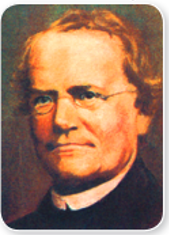
He was the first to systematically study and explain the mechanism of transmission of characteristics from the parents to the offsprings, generation after generation. Mendel published his work in the annual proceedings of the Natural History Society of Brunn.
Mendel is considered as the Father of Genetics or Modern Genetics. He was the first to introduce the concept of genes as the basic unit of heredity. Mendel called genes as factors.
Selection of garden pea as the experimental plant was based on Mendel’s meticulous and careful observations about its unique features, which are as follows:
Such an organism should have the following features.
- Shorter lifespan so that a large number of generations can be studied and examined.
- Presence of contrasting variants features.
- Ease of rearing or cultivation.
Since almost all these features were present in the garden pea plant, Mendel selected it for his experiment.
Experimental plant
Mendel conducted his experiments on Pisum sativum, the garden pea plant, for the following reasons:
- Pea plants have several distinct varieties. All the varieties have sharp contrasting characteristics, such as colour and shape of seeds.
- A pea plant bears bisexual flowers with each flower having both the male and female parts.
- The structure of the flower is such that it completely encloses the reproductive organs until fertilization, which ensures self-pollination.
- In pea plants, due to self-fertilization, it is easy to get pure lines for several generations.
- As it is an annual plant, it is possible to study several generations within a short span of time.
- The flowers of pea plants are adequate in size and easy to handle.
- Each plant can produce large number of seeds in a single generation.
Mendel selected seven pairs of contrasting characters which are listed in Table.
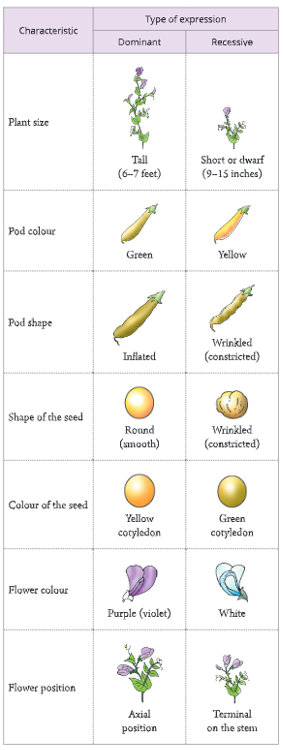
UP Board Notes for Class 10 Science Chapter 3 Heredity And Genetics Mendel’s Experiments
Mendel conducted his experiments in three stages.
Stage 1
Mendel selected seven pairs of contrasting characters. He self-pollinated the pea plant for several generations. He observed that seeds from tall plants produce only tall plants, and those from plants with purple flowers produce plants that always have purple flowers. He could, thus, obtain pure line (plants that bred true for the selected characteristic).
Stage 2
He crossed two plants showing contrasting expressions of a single trait. These were reciprocal crosses (crosses with contrasting features), for example, he crossed a true-breeding tall stem variety plant (which he called tall plant) with a true-breeding short stem variety plant (dwarf plant).
Such a cross between two parents representing contrasting forms of a single character was called monohybrid cross and the offspring was called a hybrid. In other crosses, he took two or more traits into consideration for his experiments.
Thus, the crosses in which two traits were taken into consideration were designated as dihybrid crosses. The crosses in which three traits or four traits were taken into consideration were termed as tri-hybrid and tetra–hybrid crosses, respectively.
He performed the experiment by transferring pollen grains from the anther of the tall plant to the stigma of the dwarf plant. Self-pollination was prevented
by removing all the stamens from the dwarf plant. The plants of parental generation were designated as P₁. The seeds from the dwarf plant were then collected and sown.

He allowed these plants to self fertilize. He found that all plants that grew from these seeds were tall plants. The plants in this generation were called F₁ generation or first filial generation.
Stage 3
The plants of F, generation were allowed to self-pollinate and the seeds were collected. When these seeds were sown, few plants were tall and few were dwarf, in the ratio of 3:1 (tall: dwarf). These plants were called second filial generation (or F₂ generation).
UP Board Notes for Class 10 Science Chapter 3 Heredity And Genetics Monohybrid Cross
A cross between two parents representing contrasting forms of a single trait or feature is called monohybrid cross.
In a cross between round and wrinkled seeds, Mendel cross-pollinated flowers of plants raised on the respective type of seeds (round and wrinkled). Before making such crosses Mendel ensured that all the plants involved in the crosses are of pure line. For this purpose, seeds of only those plants were used in the parental generation, which produced the desired trait for at least six generations.
Example 1 Monohybrid cross between tall and dwarf plant
UP Board Notes for Class 10 Science Chapter 3 Heredity And Genetics Cross-Pollination Between Tall And Dwarf Plants
For a monohybrid cross between tall and dwarf plants, Mendel performed the experiment by transferring pollen grains from the flower (anther) of a dwarf plant (tt) to the stigma of the previously emasculated flower of a tall plant (TT). Seeds obtained in F₁ generation were carefully observed and the observations were recorded.
In this experiment, Mendel observed that all the plants of F₁ generation were tall.
UP Board Notes for Class 10 Science Chapter 3 Heredity And Genetics Self-Pollination Of F, Generation Plants
Mendel further planted the F₁ seeds and flowers were again allowed to self-pollinate to produce the F₂ generation plants. In the F₂ generation, it was found that tall plants and short plants were obtained in the ratio of 3:1 (3 tall: 1 dwarf).
So, 3:1 is the phenotypic ratio of the monohybrid cross. In other words, three-fourth plants were tall and one-fourth were dwarf in F₂ generation (Fig. 3.4). Thus, the dwarf plant trait that disappeared in first generation reappeared in the second generation.
Mendel called the expressed trait of tallness as the dominant trait and repressed trait of both tallness and dwarfness characters were inherited in F₁ generation plants, but only the tallness trait was expressed.
The offsprings inherit two copies of traits which may be identical or different depending on their percentage. A single copy of the trait (in this case T) is enough to make tall plant while both copies of the trait have to be ‘t’ for the plant to be short. Thus, the traits like ‘T’ (expressed trait) are dominant traits
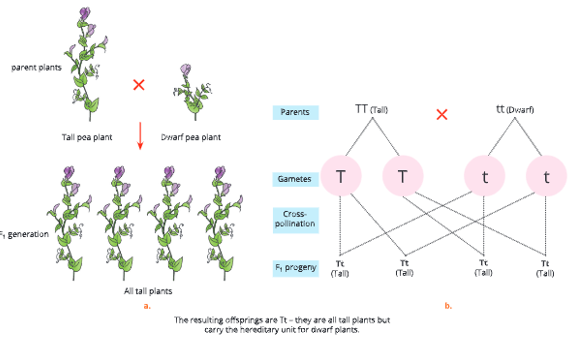
while traits like ‘t’ (repressed trait) are recessive traits. In the F₂ generation, it was found that there is one plant with genotype “TT”, two plants with genotype “Tt’ and one plant with genotype ‘tt.
So, 1: 2: 1 is the genotypic ratio of the monohybrid cross in F₂ generation. The traits of
tallness or dwarfness are inherited separately and are not mixed together.
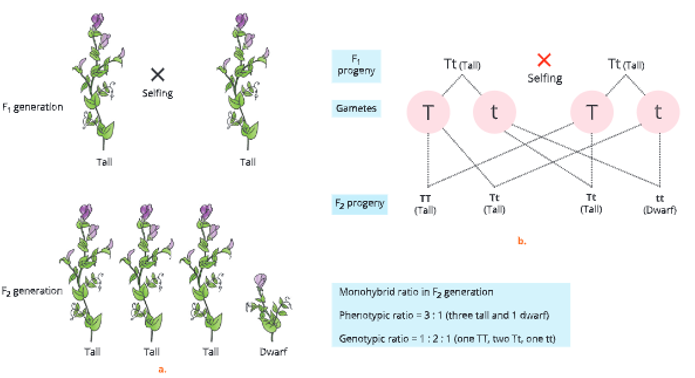
Example 2 A cross between plants with terminal flowers and axial flowers.
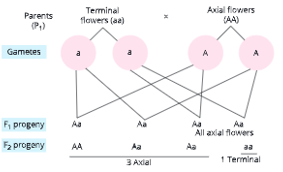
Monohybrid ratio in above cases is as follows: Phenotypic (visible feature) ratio = 3:1 (three axial, one terminal) Genotype ratio=1:2:1 (one AA, two Aa, one aa)
Dihybrid cross
A dihybrid cross is the one in which two varieties of pea plants having two contrasting characters are crossed to study the inheritance of two pairs of traits simultaneously.
For example, two plants differing in two characters like seed shape (round/wrinkled) and cotyledon colour (yellow/green) were crossed together.
Cross between yellow round and green wrinkled pea plants
Mendel selected a pure line variety of peas for yellow round seeds and another for green wrinkled seeds. He crossed these plants and observed that all F₁ generation seeds had the features of only one type (yellow coloured and round shape seeds). This showed that:
- Yellow colour of seed was dominant over green which is a recessive trait.
- Round shape of seed was dominant over wrinkled shape.
Self-pollination of F, generation plants
In the next step, Mendel self-pollinated these hybrids obtained in the F, generation. When these F₁ generation

seeds were cross-bred to raise the F₂ generation, the F₂ progeny showed four different kinds of phenotypes of seeds. It was observed that not only both the parental types (round seeds of yellow colour and wrinkled seeds of green colour) were present, but two new combination of traits (round seeds of green colour and wrinkled seeds of yellow colour) also appeared.
Thus, there were yellow round, yellow wrinkled, green round and green wrinkled seeds in the ratio of 9 : 3:3 : 1, respectively. Of these, two are of the parental P₁ types and two are new combinations or recombinants. The dihybrid ratio is, therefore, 9:3:3:1.
Interpretation of mendel’s observations
On the basis of the analysis of results of the monohybrid and dihybrid crosses, following conclusions can be drawn:
1. In a monohybrid cross, when a cross is made between the contrasting pair of a trait, only one of the traits appears in the F₁ generation.
2. The trait, which was not present in the offspring of a particular cross in F₁ generation, again reappears in the F₂ generation.
3. In a dihybrid cross, when combination of contrasting pairs of two traits were taken together, only one variety of each trait appears in the F₁ generation.
4. The other variety of each trait reappears in the F₂ generation on the same lines of the dihybrid cross.
5. However, two new combinations of the two contrasting pairs of traits in the F₂ generation also appear.
UP Board Notes for Class 10 Science Chapter 3 Heredity And Genetics Mendel’s Laws Of Inheritance
Mendel postulated three laws of inheritance on the basis of his monohybrid and dihybrid experiments.
Law 1: Law of dominance
When two alleles of contrasting character of a hereditary trait are brought together by fertilization, only one is expressed, while the other is suppressed. The characteristic which is expressed, is called dominant or expressive characteristic, and the characteristic which is repressed (not expressed), is called recessive or suppressive characteristic. Recessive character expresses only when the pair consists of both (homozygous) recessive alleles.
This is Mendel’s first law of heredity law of dominance. It states that when two homozygous individuals with one or more sets of contrasting characteristics are crossed, the characteristics which appear in the F₁ hybrids are dominant and those which do not appear in F₁ generation are recessive.
Law 2: Law of segregation
According to Mendel, each organism that reproduces sexually by producing gametes has two factors (genes) for a characteristic. Of these, one is inherited from the male parent and other from the female parent.
These are alleles for a characteristic. If the alleles are similar, they are in homozygous condition. And, if the alleles are different, they are in heterozygous condition. All gametes produced by a homozygous individual will have similar alleles. Gametes of a heterozygous individual will be dissimilar (different/not alike).
On the basis of results obtained from monohybrid cross, Mendel formulated the second law of inheritance – law of segregation. It states that when a pair of allele is brought together in a hybrid, the members of the allelic pair remain together without mixing and separate or segregate from each other when the hybrid forms gametes. Since each gamete is pure for a characteristic, the law is also known as law of purity of gametes.
Law 3: Law of independent assortment
It states that, when a dihybrid organism forms gametes,
- Each gamete receives one allele from each allelic pair (or each characteristic), and
- The assortment of alleles of different characteristics during gamete formation is independent of their parental combinations.
UP Board Notes for Class 10 Science Chapter 3 Heredity And Genetics Transmission Of Traits
All living organisms produce their own kind. So, there must be some common thing that makes an offspring similar to its parents. It is called trait or character that is passed from the parents to the offspring during sexual reproduction. These traits are transferred through genes located on their chromosomes.
UP Board Notes for Class 10 Science Chapter 3 Heredity And Genetics What Are Genes?
Genes:
A segment of DNA on a chromosome which codes for the synthesis of a specific protein is called gene. Genes are the units of heredity. They are located in a linear fashion on chromosomes. Thus, chromosomes are the carriers of genes. These are located within the cell nucleus.
In normal condition, each gene has two alternative forms of a character producing different effects. These alternative forms are called alleles.
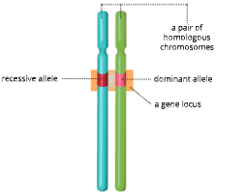
In humans, all chromosomes are present in pairs within the cell nucleus. Therefore, all genes are also in pairs, i.e. each character has two alleles, each present on one chromosome of the pair. Two alleles of a pair are always located at the same position on the chromosome pair.
The position is called a gene locus. Both the parents contribute equally to the DNA of progeny during sexual reproduction. That means, both parents contribute a copy of the same gene. During meiosis, a gamete receives only one chromosome of a pair.
Hence, each gamete (germ cell) has only one allele of the pair of alleles for a character. When two germ cells combine, they will restore the normal number of chromosome in the progeny and ensure the stability of the DNA of the species.
The characters thus pass from the parents to the offsprings in the form of genes on chromosomes. They are transmitted physically. Thus genes are the physical basis of heredity.
Dominant and recessive alleles
Out of the two alleles of a gene, the allele that masks any phenotypic effect of any recessive allele is called the dominant allele, while the allele that is masked is called the recessive allele. For example, the allele controlling the rolling of tongue is the dominant allele and the allele which controls the condition in which tongue cannot be rolled is the recessive allele.
Genotype and phenotype
The genetic constitution of an organism in which the genes are present in various combinations is called genotype. On the other hand, the externally visible expression of genes, which is an inherited feature in an individual’s appearance is called phenotype. For every phenotype, there may be two conditions, homozygous and heterozygous.
Homozygous condition: A condition in which a pair of a homologous chromosomes carries identical alleles on a gene locus for a specific trait.
Heterozygous condition: A condition in which a pair of homologous chromosomes carries non-identical alleles on a gene locus for a specific trait.
Pedigree analysis – From parents to children
In the pedigree analysis, a family’s history for a particular trait is collected. Then, this information is assembled into a family tree describing the interrelationship of parents and children across generations.
Thus, a pedigree is a family tree or a chart describing the inheritance of a particular character across generations. A pedigree analysis of a recessive trait (attached earlobes) is described in Figure 3.7.
In this case, the first born daughter in the third generation has attached earlobes, although her parents lack that trait (they had free earlobes). Thus, thepresence of attached earlobe phenotype is due to a recessive allele.

UP Board Notes for Class 10 Science Chapter 3 Heredity And Genetics Sex Determination In Human Beings – Son Or Daughter?
Determining the sex of an individual at prenatal (before birth or during pregnancy) stage is called sex determination. In a number of organisms, one specific pair of chromosome plays a significant role in the determination of sex of the organisms. These chromosomes are named as sex chromosomes. In human beings, there are 23 pairs of chromosomes, out of which one pair is sex

chromosome. There are two types of sex chromosomes- X and Y. A female contains two X chromosomes (i.e. homomorphic), while a male contains one each, i.e. X and Y chromosomes (i.e. heteromorphic). Rest of the 22 pairs of chromosomes are exactly similar and are called the autosomes.
At the time of reproduction, during gamete formation these paired chromosomes separate. Thus, two types of gametes are formed in males (one containing X chromosome while the other containing Y chromosome).
Half of the male gametes or sperms carry the X chromosomes and rest half have Y one X chromosome. 22 pairs of autosomes are equally distributed in both sperm and ovum, and hence they are similar in terms of autosomes. Thus, the female has 44 + XX chromosomes and male has 44+ XY chromosomes.
How is it determined if the child would be male or female?
- The sex of the offspring will be determined by the type of chromosome (X or Y) inherited from father.
- At the time of fertilization, when the sperm and the egg unite to form a zygote, each individual inherits one of the two possible combinations of
- A zygote (XX) with two X chromosomes (one from father and one from mother) develops into a girl while a zygote, (XY) with one X chromosome (from mother) and one Y chromosome (from father) develops into a boy.
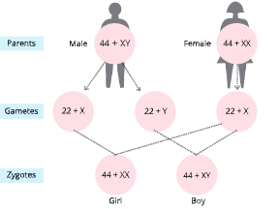
UP Board Notes for Class 10 Science Chapter 3 Heredity And Genetics Sex-Linked Inheritance
Most genes of an organism are located on autosomes. Genes of sexual characters are located on the sex chromosomes. However, genes of some characteristics which are not related to the sex of the organism are also located on the sex chromosomes.
These are sex-linked characters because their inheritance is sex-linked. Inheritance of non-sexual characters or traits due to the presence of an allele on sex chromosomes is called sex-linked inheritance. These characteristics may be present either on X chromosome or Y chromosome or both.
X-linked inheritance
X-linked genes are present on that portion of the X chromosome for which there is no homologous region on the Y chromosome. Examples of inheritance of traits determined by X-linked genes include colour blindness and haemophilia.
These diseases are caused by recessive alleles located on the X chromosome. Mostly males suffer from these disorders and females are rarely affected. A person suffering from colour blindness is unable to distinguish between red and green colours.
Haemophilia is a sex linked recessive disorder that slows down the process of blood clotting in an affected individual. It results in prolonged bleeding following an injury. It is rare to have haemophilia in females but they act as the carrier and may transfer the mutated gene their sons.
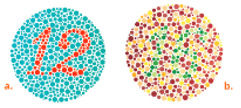
UP Board Notes for Class 10 Science Chapter 3 Heredity And Genetics Inheritance Of Colour Blindness Or Haemophilia
Let us understand how colour blindness is an X-linked characteristic. X chromosomes having the two alternative alleles of the colour blind characteristic are indicated as:
Alleles
X-normal (dominant allele)
Xº – colour blind allele (recessive allele)
Possible genotypes of females
XX- normal female
XX° – carrier female (does not show
symptoms of the disease)
X’X’ – colour blind female
Possible genotypes of males
XY – normal male
X’Y – colour blind male
Now let us take two situations.
Situation 1: A cross between carrier female vs normal male
Parents
Carrier mother Normal father
XX°
XY
Punnet square
Sperms from
normal father
X
XX
XXX
X Y
XY
50% of the progeny are normal. One daughter (25% of the progeny) is the carrier of the defective allele. One son (25% of the progeny) is colour blind.
Situation 2: A cross between normal female and colour-blind male
Normal mother
XX
Colour blind father
Xº Y
Sperms from
colour blind father
X Y
XXX° XY
XXX° XY
XX° – Daughters-heterozygous dominant, carrier
of colour blindness but with normal vision.
XY – Normal sons
None of the child colour l but daughters are carriers of the defective alleles for colour blindness.
From the given crosses, it can be concluded that,
- an X-linked recessive gene affects more males than females because males need only one copy of the defective allele to express the characteristic.
- an X-linked recessive characteristic can skip generations because males can receive an X-linked recessive only from their mothers and very few females are homozygous for the gene.
UP Board Notes for Class 10 Science Chapter 3 Heredity And Genetics What Would Happen If The X-linked Genes Were Dominant?
If the X-linked genes were dominant then:
The pattern of inheritance of an X-linked domainant gene is different from the X-linked recessive one. In this case, both males and females are equally affected by the presence of the gene. Irrespective of sex, half the male and female offsprings are affected by the gene or trait. Inheritance of defective tooth enamel is an example of X-linked dominant inheritance.
Y-linked gene
The gene for hairy pinna is an example of Y-linked inheritance. Will it be expressed if it were in the recessive form? Of course, yes, the gene shall be expressed irrespective of it being dominant or recessive. Can you guess the reason? Y chromosome is present singly in the male genotype. Will females be carriers of this gene? The obvious answer is no as the human female genotype does not have a Y chromosome. The characteristics of a Y-linked trait are as follows.
- They are expressed only in males.
- They are always passed from father to son.
UP Board Notes for Class 10 Science Chapter 3 Heredity And Genetics Mutation
A sudden change in the amount, arrangement or structure of the DNA or chromosomes of an organism is called mutation. The mutation alters the hereditary material of an organism’s cell and may or may not be inherited cells. A mutation may results in a change in the genetic appearance of a characteristic in a population.
- Mutations occurring in gamete cells are inherited while those occurring in somatic cells (called somatic mutations) are usually not inherited.
- A mutation resulting from a change in the amount or arrangement of the DNA is known as chromosomal mutation.
- A mutation resulting from a change in the structure of gene in DNA is known as gene mutation.
Causes of mutation
Mutation can be caused by a variety of chemical substances such as mustard gas, caffeine, gamma rays and X-rays and sometimes even certain pesticides.
Sickle cell anaemia is an example of disease caused due to mutation. It is a blood disorder characterized by red blood cells that assume an abnormal, sickle shape due to the sudden change in DNA structure.
Genetic engineering
A technique in which the genetic constitution of an organism can be altered by introducing new genes or replacing existing genes into its chromosomes is known as genetic engineering. For example, insulin-producing genes are introduced in a bacteria to produce insulin.
Genetic counselling
This is a counselling of the parents/newly married couples in which they are advised to get them screened rany genetic diseases such as haemophilia, thalassemia, Down syndrome, etc.
UP Board Notes for Class 10 Science Chapter 3 Heredity And Genetics Summary
- The science that deals with the mechanisms responsible for similarities and differences among closely related members of the species is called genetics.
- Gregor Mendel is considered as the father of genetics. He postulated three laws of heredity on the basis of his experiments on the sweet pea plant.
- Mendel’s first law of inheritance: Law of dominance states that when two homozygous individuals with one or more sets of contrasting characteristics are crossed, the characteristics which appear in F, hybrids are dominant.
- Mendel’s second law of inheritance: Law of segregation states that when a pair of alleles is brought together in a hybrid, the members of the allelic pair remain together without mixing and separate or segregate from each other when the hybrid forms gametes.
- Mendel’s third law of inheritance: Law of independent
- assortment states that when a dihybrid organism forms gametes, each gamete receives one allele
from each allelic pair (of each characteristic), and the assortment of alleles of different characteristics during gamete formation is independent of their parental combinations. - Pedigree is a family tree or a chart describing the inheritance of a particular characteristic across generations.
- Sex determination in humans is based on combination of sex chromosomes. Females have two X chromosomes while males have one X and one Y chromosome.
- Inheritance of non-sexual characteristics through sex chromosomes is called sex-linked inheritance. It may be either X-linked recessive/dominant or Y-linked.
- Colour blindness and haemophilia are examples of X-linked inheritance mostly in human males.
